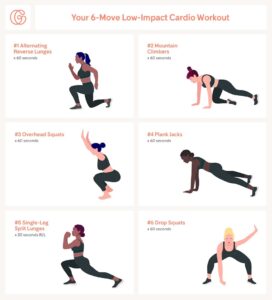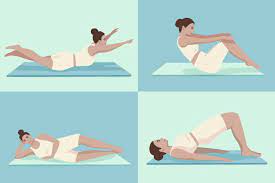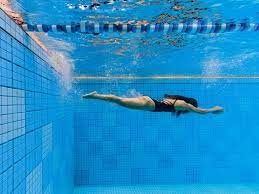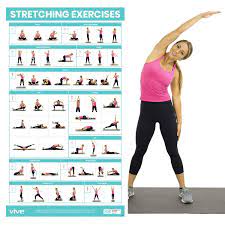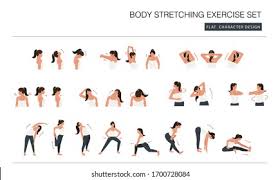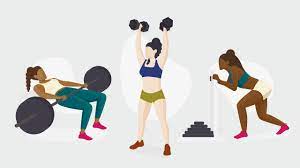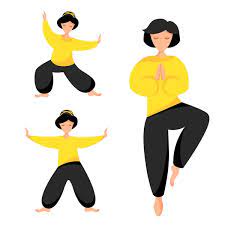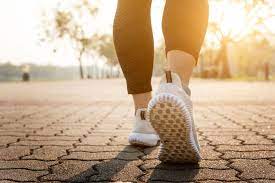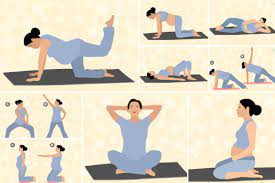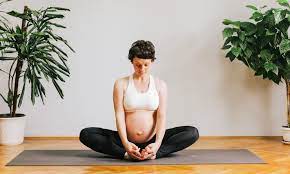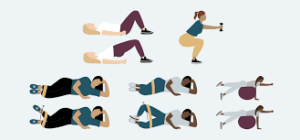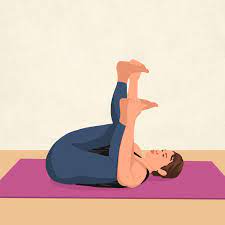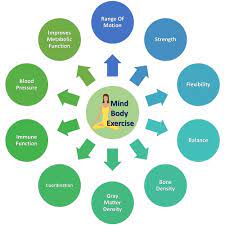Exercises for women’s health-
Exercising during menstruation can be beneficial for many women, as it can help alleviate menstrual symptoms such as cramps, fatigue, and mood swings. However, it’s essential to choose exercises that feel comfortable and to listen to your body. Here’s a detailed overview of exercises suitable during periods:
1. Low-Impact Aerobic Exercises:
Activities such as walking, gentle jogging, or cycling at a moderate pace can help increase blood circulation and alleviate menstrual cramps.
– Low-impact aerobics or dance-based workouts can be beneficial for boosting mood and energy levels without putting excessive strain on the body.
2. Yoga:
– Gentle yoga poses can help stretch and relax muscles, reducing tension and alleviating menstrual cramps.
– Focus on poses that target the lower back, hips, and abdomen, such as Child’s Pose, Cat-Cow Stretch, and Supine Twist.
– Restorative yoga, which involves supported poses and deep breathing, can promote relaxation and relieve stress.
3. Pilates:
– Pilates exercises focusing on core strength and stability can help alleviate menstrual discomfort and improve posture.
– Choose gentle, modified exercises that avoid excessive strain on the abdominal muscles, such as pelvic tilts and leg slides.
4. Swimming:
– Swimming is a low-impact exercise that can help relieve menstrual cramps and reduce bloating.
– The buoyancy of water supports the body, making it an excellent choice for gentle, soothing exercise during periods.
5. Stretching:
– Gentle stretching exercises can help relieve muscle tension and reduce menstrual cramps.
– Focus on stretching the lower back, hips, thighs, and abdomen to alleviate discomfort.
6. Light Strength Training:
– Light strength training exercises using bodyweight or light resistance can help maintain muscle tone and strength during menstruation.
– Focus on exercises that target major muscle groups, such as squats, lunges, and gentle abdominal exercises.
7. Tai Chi or Qi Gong:
– Tai Chi and Qi Gong involve slow, flowing movements combined with deep breathing, promoting relaxation and stress relief.
– These gentle exercises can help improve balance, flexibility, and overall well-being during menstruation.
8. Mindfulness Meditation:
– Mindfulness meditation involves focusing on the present moment and observing thoughts and sensations without judgment.
– Practicing mindfulness meditation can help reduce stress, alleviate menstrual symptoms, and promote a sense of calm and well-being.
9. Walking or Gentle Movement:
– If you’re not up for structured exercise, even a short walk or gentle movement such as stretching at home can help improve circulation and alleviate discomfort.
It’s important to listen to your body and choose exercises that feel comfortable and supportive during menstruation. If you experience severe pain or discomfort, it’s best to consult with a healthcare professional before engaging in any physical activity. Additionally, staying hydrated and practicing good self-care, such as getting enough rest and managing stress, can also help alleviate symptoms during menstruation.
Beneficial exercises During pregnancy –
Exercising during pregnancy can be highly beneficial for both the mother and the baby, but it’s crucial to do so safely and with guidance from a healthcare provider. Here’s a detailed overview of exercising during pregnancy:
1. Consultation with Healthcare Provider:
Before starting or continuing any exercise regimen during pregnancy, it’s essential to consult with your healthcare provider. They can provide personalized recommendations based on your health history, current pregnancy status, and any potential risk factors.
2. Types of Exercises:
a. Low-Impact Aerobic Activities: Walking, swimming, stationary cycling, and low-impact aerobics are generally safe options during pregnancy. These activities help improve cardiovascular health, increase endurance, and boost mood without putting excessive stress on the joints.
b. Prenatal Yoga: Prenatal yoga focuses on gentle stretching, breathing exercises, and relaxation techniques tailored to the needs of pregnant women. It helps improve flexibility, balance, and circulation while reducing stress and promoting relaxation.
c. Strength Training: Strength training exercises using light weights or resistance bands can help maintain muscle tone and strength during pregnancy. Focus on exercises that target major muscle groups, such as squats, lunges, bicep curls, and tricep extensions. Avoid heavy lifting and exercises that require lying flat on your back after the first trimester.
d. Pelvic Floor Exercises: Kegel exercises are designed to strengthen the pelvic floor muscles, which can help prevent urinary incontinence and support the pelvic organs during pregnancy and childbirth. To perform Kegels, contract the muscles used to stop the flow of urine and hold for a few seconds before releasing.
e. Flexibility and Stretching: Gentle stretching exercises can help alleviate muscle tension, improve flexibility, and reduce the risk of cramping. Focus on stretching major muscle groups, such as the hamstrings, calves, chest, and shoulders.
3. Safety Guidelines:
a. Stay Hydrated: Drink plenty of water before, during, and after exercise to stay hydrated.
b. Monitor Intensity: Aim for a moderate level of intensity during exercise, where you can comfortably carry on a conversation. Avoid overexertion and listen to your body’s signals.
c. Proper Form: Pay attention to proper form and technique during exercises to prevent injury. Avoid sudden movements or jerky motions.
d. Wear Supportive Gear: Wear supportive, comfortable footwear and a well-fitted sports bra to provide adequate support to your changing body.
e. Avoid Overheating: Exercise in a well-ventilated area and avoid overheating, especially during hot and humid weather. Wear loose, breathable clothing.
4. Warning Signs to Stop Exercising:
a. Vaginal bleeding or fluid leakage
b. Severe abdominal or pelvic pain
c. Dizziness or faintness
d. Shortness of breath before exertion
e. Chest pain or palpitations
f. Headache
g. Muscle weakness
h. Decreased fetal movement
Always listen to your body and adjust your exercise routine as needed throughout pregnancy. If you experience any discomfort or have concerns about exercising during pregnancy, consult with your healthcare provider for guidance.
Other helpful exercises-
Engaging in regular physical activity is not only beneficial for physical health but also for emotional and mental well-being. Here are some exercises tailored for women that can contribute to overall health, along with their benefits:
1. Yoga:
– Physical Benefits: Improves flexibility, muscle strength, and posture. It also helps with weight management and cardiovascular health.
– Emotional Benefits: Reduces stress, promotes relaxation, and increases body awareness.
– Mental Benefits: Enhances concentration, improves mood, and fosters mental clarity.
2. Cardiovascular Exercises (e.g., Running, Cycling, Swimming):
– Physical Benefits: Boosts heart health, improves endurance, and burns calories for weight management.
– Emotional Benefits: Releases endorphins, which can alleviate symptoms of depression and anxiety.
– Mental Benefits: Enhances cognitive function, improves sleep quality, and reduces the risk of cognitive decline.
3. Strength Training (e.g., Weightlifting, Bodyweight Exercises):
– Physical Benefits : Builds muscle mass, increases bone density, and improves metabolism.
-Emotional Benefits: Boosts self-esteem and body confidence.
– Mental Benefits: Enhances focus and discipline, reduces the risk of injury by strengthening muscles and joints.
4. Pilates:
– Physical Benefits: Improves core strength, flexibility, and posture.
–Emotional Benefits: Increases body awareness and promotes relaxation.
– Mental Benefits: Enhances concentration and mindfulness, reduces stress levels.
5. Dance Fitness (e.g., Zumba, Dance Aerobics):
– Physical Benefits: Burns calories, improves coordination, and cardiovascular health.
– Emotional Benefits: Boosts mood, reduces stress, and enhances social interaction.
– Mental Benefits: Increases self-expression and creativity, improves memory and cognitive function.
6. Mindfulness Meditation:
– Physical Benefits: Reduces muscle tension and lowers blood pressure.
– Emotional Benefits: Helps in managing stress, anxiety, and depression.
– Mental Benefits: Improves focus, enhances emotional regulation, and fosters a sense of inner peace.
7. Outdoor Activities (e.g., Hiking, Biking, Nature Walks):
– Physical Benefits: Provides exposure to fresh air and sunlight, promotes vitamin D synthesis, and improves overall fitness.
– Emotional Benefits: Enhances mood and reduces symptoms of depression.
– Mental Benefits: Reduces rumination, improves cognitive function, and boosts creativity.
8. Group Fitness Classes (e.g., Kickboxing, Spin Classes):
– Physical Benefits: Offers a structured workout routine, increases motivation, and provides accountability.
– Emotional Benefits: Fosters a sense of community and support, reduces feelings of loneliness.
– Mental Benefits: Boosts confidence, improves mood, and reduces stress through social interaction.
Incorporating a variety of these exercises into your routine can lead to holistic benefits for physical, emotional, and mental health. It’s important to find activities that you enjoy and that align with your individual preferences and goals. Additionally, consulting with a healthcare professional before starting any new exercise regimen is advisable, especially if you have any underlying health conditions.
Beneficial exercises During menopause –
Exercising during menopause is crucial for maintaining overall health and well-being, as it can help alleviate symptoms, reduce the risk of certain health conditions, and improve quality of life. Here’s a detailed overview of exercises suitable during menopause:
1. Cardiovascular Exercises:
– Activities such as brisk walking, jogging, cycling, swimming, or dancing can help improve cardiovascular health and endurance.
– Aim for at least 150 minutes of moderate-intensity aerobic exercise per week, or 75 minutes of vigorous-intensity exercise, spread throughout the week.
2. Strength Training:
– Strength training exercises using weights, resistance bands, or bodyweight can help maintain muscle mass, bone density, and metabolism during menopause.
– Focus on compound exercises that target multiple muscle groups, such as squats, lunges, deadlifts, push-ups, and rows.
– Aim for at least two days per week of strength training, incorporating exercises for all major muscle groups.
3. Flexibility and Balance Exercises:
– Stretching exercises and activities that improve flexibility and balance are essential for maintaining mobility and reducing the risk of falls.
– Incorporate yoga, Pilates, tai chi, or simple stretching routines into your exercise regimen to improve flexibility and balance.
– Focus on movements that target tight or stiff areas, such as the hips, lower back, shoulders, and hamstrings.
4. Bone-Strengthening Exercises:
– Weight-bearing exercises help maintain bone density and reduce the risk of osteoporosis, a common concern during menopause.
– Activities such as walking, jogging, hiking, dancing, stair climbing, and resistance training can help strengthen bones and reduce the risk of fractures.
– Aim for at least 30 minutes of weight-bearing exercise on most days of the week.
5. Pelvic Floor Exercises:
– Pelvic floor exercises, also known as Kegel exercises, can help improve pelvic floor muscle strength and reduce urinary incontinence, a common symptom during menopause.
– To perform Kegels, contract the pelvic floor muscles as if you’re trying to stop the flow of urine, hold for a few seconds, then relax. Aim for three sets of 10 repetitions daily.
6. Mind-Body Exercises:
– Mind-body exercises such as yoga, tai chi, and meditation can help reduce stress, improve mood, and promote relaxation during menopause.
– These practices can also help manage symptoms such as hot flashes, insomnia, and mood swings by promoting a sense of calm and well-being.
7. Interval Training:
– High-intensity interval training (HIIT) can be an effective way to improve cardiovascular fitness and burn calories during menopause.
– Incorporate short bursts of high-intensity exercise followed by periods of rest or lower-intensity exercise to maximize benefits in less time.
It’s essential to choose exercises that you enjoy and that fit your fitness level and preferences. Additionally, consulting with a healthcare provider before starting any new exercise regimen is advisable, especially if you have any underlying health conditions or concerns. Adjust your exercise routine as needed based on your individual needs and listen to your body’s signals to prevent injury and promote overall health and well-being during menopause.


